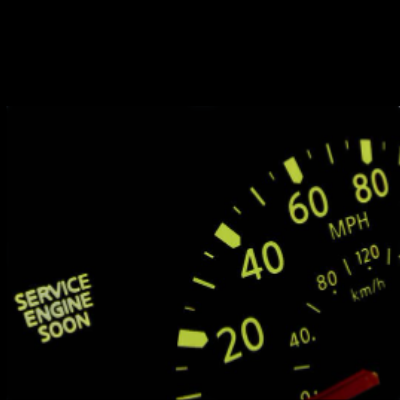Dec 7, 2020

Despite the fact that cars are now being made more reliable, it’s natural that they can still suffer from some problems due to the complex technology being used. A dashboard warning light is often the first sign of an issue and is designed to tell drivers that the trouble is early on and it needs to be looked at to prevent further damage to the car.
The Engine Management Light is one of the most common dashboard lights and if you put your car through MOT with this light on, you will fail.
Why do engine lights cause MOT failure?
Your car will fail the MOT if the engine warning light is on because under the new MOT rules, it’s now classed as a major fault. There are many reasons why the engine light might be on but some will be more straightforward than others. If your light is on constantly or if it’s flashing, you should have your car checked at a garage.
What is an engine management warning light?
Unlike the other dashboard warning lights, the engine warning light doesn’t alert you to a specific fault. Unlike the coolant temperature light or ABS light, the engine light can illuminate due to a number of reasons. A flashing or continuous warning light can show that your engine isn’t running as it should be.
If the warning light is amber, it doesn’t necessarily point to an unfolding emergency, you should be able to continue and seek advice on reaching your desired destination. However, if it’s a red light, you should pull over when it is safe to do so as driving any further could cause more expensive damage.
Why is my engine light on?
There are a number of reasons why your engine management light will come on but here are the most common causes:
Oxygen sensor malfunction (emissions)
The oxygen sensor measures the amount of oxygen that goes unburned in the car’s exhaust system and a failed O2 sensor causes more fuel to be burned than necessary.
Loose/faulty petrol filler cap
Engine management lights don’t always mean a major problem and sometimes it can be as simple as a loose or faulty petrol filler cap. You may have just driven away without completely tightening the cap.
Catalytic converter
The catalytic converter turns harmful carbon monoxide into carbon dioxide and if your car is regularly serviced then it shouldn’t completely fail. These issues can stem from other parts failing such as the EGR valve.
Faulty spark plugs/ignition system
Spark plugs ignite the fuel in your engine’s combustion chamber and if the wiring fails, you will notice a decrease in the engine power as well as stalling.
EGR valve failing
The EGR valve controls the amount of nitrogen oxide in the car’s engine helping to improve its efficiency and it can become stuck open or closed due to a build up of particles causing the engine light to come on.
Fuel injector and pump problems
Fuel injectors moderate the amount of fuel delivered to your car’s engine combustion chamber and when they clog, they will underperform or fail entirely. A failing fuel pump will cause incorrect amounts of fuel to be delivered causing the ECU to report a fault and the check engine light will come on.
Is your MOT coming up and the engine light has just popped up on the dashboard? Get your car checked over by a mechanic and gather quotes from local mechanics in your area with MyCarNeedsA.com. Get your quotes today to save you both time and money!